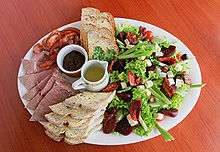Salad bowl (cultural idea)

The salad bowl concept suggests that the integration of the many different cultures of United States residents combine like a salad, as opposed to the more traditional notion of a cultural melting pot. New York City is an example of the "salad bowl". In Canada this concept is more commonly known as the cultural mosaic.[1] In the salad bowl model, various American cultures are juxtaposed — like salad ingredients — but do not merge into a single homogeneous culture. Each culture keeps its own distinct qualities. This idea proposes a society of many individual, "pure" cultures in addition to the mixed culture that is modern American culture, and the term has become more politically correct than melting pot , since the latter suggests that ethnic groups may be unable to preserve their cultures due to assimilation.
Some have compared the European concept of multiculturalism (multikulti) to a salad bowl approach, which prevents the full integration of immigrant groups into host societies, whereas the traditional American approach of the melting pot results in successful integration of successive immigrant waves into the larger American society.
The love story of Pocahontas and John Smith in a well known Disney animation film Pocahontas (1995) or the peaceful co-existence of Native Americans and new immigrants from England has been counted as a prototype of American multiculturalism. However, some scholars blamed it as a WASP-oriented (White Anglo-Saxon Protestant) concept of melting pot and suggested a new concept of salad bowl.
An example of the European version of a salad bowl can be seen in its policy regarding the EU programme ‘integration of non-European nationals’ which finances and promotes integration initiatives targeting those who are not members of the EU25. This project aims to encourage dialogue in civil society, develop integration models, and spread and highlight the best initiatives regarding integration.
The salad bowl idea in practice has its supporters and detractors. Supporters argue that being American is not inherently tied to a single culture, but rather to citizenship and loyalty to the United States. Thus, one does not need to abandon one's own cultural heritage in order to be considered "American". Critics tend to oppose the idea in tandem with other critiques on multiculturalism, saying that America needs to have a common culture in order to preserve a common "American" identity.
Scholars such as Yale University’s Amy Chua argue for a different version of multiculturalism: the salad bowl. In her book Day of Empire: How Hyperpowers Rise to Global Dominance and Why They Fall, she suggests 'cultural tolerance' as a prerequisite to be a global dominance or hyperpower. Evaluating the United States is on the verge of losing that very ideal characteristic in recent years, she wishes for America to remain as a tolerant nation in the context of globalization and multiculturalism. Her conception of tolerance may be understood as multi-culturalism or figuratively salad bowl. In other words, scholars like Chua call for a coexistence of different race, ethnic groups, and cultures with their own unique forms, like in a salad bowl, rather than requiring them to assimilate into the one created by the dominating majority.
See also
References
- ↑ Kalman, Bobbie (2010). Canada: The Culture. Crabtree Pub. p. 4. ISBN 978-0-7787-9284-0. Retrieved 2012-06-04.
- Sollars, Werner. Beyond Ethnicity: Consent and Descent in American Culture. 1987
- Lind, Michael. The Next American Nation: The New Nationalism and the Fourth American Revolution. 1996
- Schmidt, Alvin J. The Menace of Multiculturalism: Trojan Horse in America. 1997
- Huntington, Samuel P. Who Are We?: The Challenges to America's National Identity. 2005
- Chua, Amy. Day of Empire: How Hyperpowers Rise to Global Dominance and Why They Fall. 2007
- Kolb, Eva. The Evolution of New York City's Multiculturalism: Melting Pot or Salad Bowl. 2009